Monterey Bay "Masked" Booby
13 Feb 1999
A discussion of identification by Don Roberson
Photo © Richard Ternullo
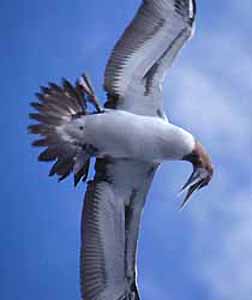 In the middle of Monterey Bay on 13 Feb 1999, this juvenal-plumaged "Masked"
Booby appeared over a Shearwater Journey's pelagic trip, delighting all
hands. Dylan Holstein states (quoting from the Shearwater
Journeys web page) that "the bird was seen in a flock of gulls near
the end of the trip among a flock of gulls just before we crossed from
Santa Cruz County back into Monterey County. The boat chased the bird and
eventually caught up with it. It flew over the boat several times and even
at one point dive-bombed a fish." Those aboard -- including Debi Shearwater,
Al DeMartini, Dylan Holstein -- correctly ruled out Brown Booby and identified
this as a "Masked Booby" (sensu 7th ed. AOU). Skipper Richard Ternullo
and professional photographer John Sorensen both obtained some very nice
photos. Some aboard had read my recent paper in Field Notes 52:
276-287 (1998) "Sulids Unmasked: which large booby reaches California?"
and therefore considered the separation of the pantropical Masked Booby
S.
dactylatra from the recently split Nazca Booby S. granti of
the Galapagos (a split proposed by Pitman & Jehl (1998) Wilson Bull.
110: 155-170, but not yet adopted by AOU although I expect it eventually
will be adopted widely). My paper showed that several adult Masked Boobies
(sensu strictu) have occurred in California, quite possibly from both the
Revillagigedos populations and those in the Central Pacific, but that juvenal
birds in April (3 records in California and adjacent Baja California) were
most likely Nazca Boobies. So either could occur here.
In the middle of Monterey Bay on 13 Feb 1999, this juvenal-plumaged "Masked"
Booby appeared over a Shearwater Journey's pelagic trip, delighting all
hands. Dylan Holstein states (quoting from the Shearwater
Journeys web page) that "the bird was seen in a flock of gulls near
the end of the trip among a flock of gulls just before we crossed from
Santa Cruz County back into Monterey County. The boat chased the bird and
eventually caught up with it. It flew over the boat several times and even
at one point dive-bombed a fish." Those aboard -- including Debi Shearwater,
Al DeMartini, Dylan Holstein -- correctly ruled out Brown Booby and identified
this as a "Masked Booby" (sensu 7th ed. AOU). Skipper Richard Ternullo
and professional photographer John Sorensen both obtained some very nice
photos. Some aboard had read my recent paper in Field Notes 52:
276-287 (1998) "Sulids Unmasked: which large booby reaches California?"
and therefore considered the separation of the pantropical Masked Booby
S.
dactylatra from the recently split Nazca Booby S. granti of
the Galapagos (a split proposed by Pitman & Jehl (1998) Wilson Bull.
110: 155-170, but not yet adopted by AOU although I expect it eventually
will be adopted widely). My paper showed that several adult Masked Boobies
(sensu strictu) have occurred in California, quite possibly from both the
Revillagigedos populations and those in the Central Pacific, but that juvenal
birds in April (3 records in California and adjacent Baja California) were
most likely Nazca Boobies. So either could occur here.
Most views were from below, and showed many features that rule out Brown
Booby, including a pale eye, a demarcation line between dark head and white
chest at the base of neck (not at chest even with leading edge of wing),
and more extensive white in the underwings. Note also the whitish inners
webs to the outer rectrices on the left hand photo (and also the first
photo above top; more about this feature below).
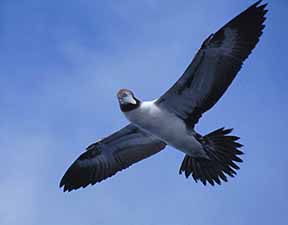
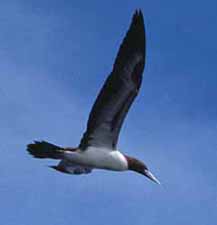
Booby, Monterey Bay, 13 Feb 1999; left photo © Richard
Ternullo; right photo © John Sorensen
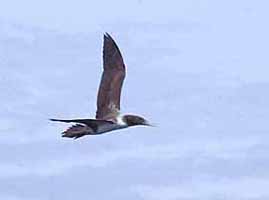
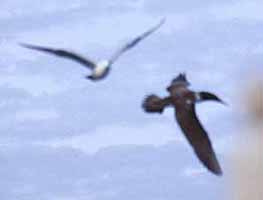
Booby, Monterey Bay, 13 Feb 1999; both photos ©
Richard Ternullo
Because this booby had an obvious white cervical collar (two photos
above), the preliminary identification was that of a juvenal Masked Booby
(sensu strictu; excluding Nazca Booby). Yet some observers, including Holstein,
questioned this since it was also apparent that the bird had a darker head
than mantle. All observers agreed the bill was still dark gray or bluish-gray
with a yellowish tip. This pattern is shown by juvenals of both Masked
and Nazca boobies; older birds may be identified by the color at the base
of the bill (yellow to yellow-green in Masked; orange to pinkish in Nazca).
In my paper, I presented data suggesting that all juvenal Masked
Boobies around the world have white cervical collars except a small
percentage (20%) of the race S. d. californica which breed primarily
on Clipperton I. and the Revillagigedos. In contrast, some 77% of juvenal
Nazca Boobies lack a cervical collar. Yet the trend is exactly the opposite
on the contrast between head and back. My survey showed that the vast majority
of Masked Boobies around the world lack any contrast between head and back
(both being dark rich brown), but that a majority (55%) of Nazca Boobies
show a distinct contrast between head and back with many looking "gray-backed"
at a distance. [These statistics were derived from a limited sample of
specimens and photos of known identity birds, and were biased toward some
nesting colonies because more skins were taken there or more photos shot
nearby, so that the "real" percentages are likely somewhat different.]
Since this Monterey Bay bird has both a collar and contrast between
head and back, I think we can limit the discussion to two groups of birds:
this is either (a) a Masked Booby of the race californica which
is one of the 20% that show head/back contrast, or (b) a Nazca Booby showing
typical head/back contrast but among the small percentage (~23%) that have
a collar. [While it is true that most Nazca Boobies lack a collar, my paper
also suggested that the "collared" Nazca Boobies come mostly (entirely?)
from Culpepper and Wenman islands, the northernmost nesting islands of
S.
granti and the closest in range to S. d. californica, where
they may even be in the majority of that sub-population.] So we are faced
with the most difficult identification problem possible -- a bird which
is showing characteristics present on only a minority of young birds of
its species. I present below two photos from my paper, taken by Bob Pitman,
which show the close approach in characters of these difficult birds (the
top photo is a juvenal Masked Booby just off Clipperton I. in March 1983;
the one below a juvenal Nazca Booby just off Wenman I. in July 1986):
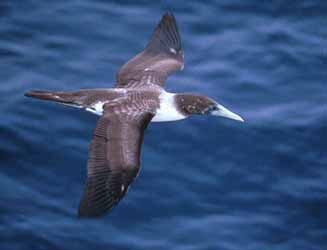 Both
photos © Robert L. Pitman
Both
photos © Robert L. Pitman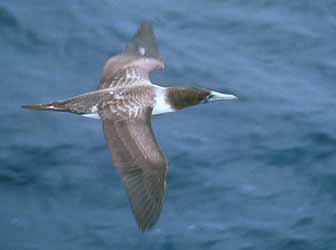
While these two birds are very similar (and the photos were chosen because
these were the two most similar individuals of the two species I could
find), there still are subtle differences. The Nazca Booby (bottom) shows
even more contrast between the head and back than the Masked (and thus
looks more "gray-backed", especially at a distance). Perhaps more important,
the cervical collar on the Masked Booby is very broad, cleanly white, and
well-demarcated, while that on the Nazca Booby is narrower, less clean,
and the demarcation edges are fuzzy. In fact, there appears to a slight
wash of brownish collar right at the base of the neck which vaguely connects
the head and back. Both of these birds show a little white at the base
of the tail feathers, another feature that converges, but while many Nazca
Boobies have such "white frosting" to the tail base (43%) only the most
extreme Maskeds (12%, and only in race californica) show this feature.
Below are close-up photos of the Monterey Bay mystery booby focusing
on the collar and the bill


Booby, Monterey Bay, 13 Feb 1999; left © Richard
Ternullo; right © John Sorensen
Turning first to the collar, to my eye the collar of the Monterey Bay
bird is less than a clean, crisply-white, broad collar. Rather, its edges
are fuzzy and there is a narrow wash of brownish down the top of the neck
which vaguely connects the dark brown head to the paler brown back. This
is a character of Nazca Booby that I did not find in any Masked Booby.
Further, although it may just be my eyes, I think I see a hint of dusty
purplish-rose color to the base of the bill (consistent with Nazca Booby;
see cover of Field Notes, Vol. 52, No. 3). Even if I'm exaggerated
any color there, at least it does not look darkish yellow-green like a
Masked as it first changes color.
I did not adequately research underwing patterns -- or other ventral
characters -- in the paper that was published, and there may be no significant
differences. However, just for the record, here are the ventral patterns
of known Masked (left) and Nazca (right) boobies (both photos
© D. Roberson; left at 17°30'N, 122°30W in Sep 1989, right
19°N,115°W in Aug 1989):
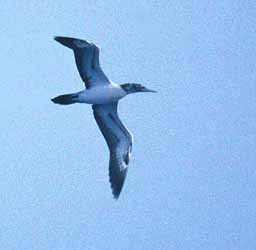
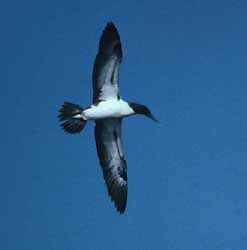
 Note that both birds are still in full juvenal plumage without wing molt.
That is also true of the Monterey Bay mystery booby. I do see a lot of
white in the base of the rectrices on the Nazca Booby which is not apparent
on the Masked Booby (although that bird's tail is not spread so it is hard
to compare directly; however, I don't have a photo of juv. Masked with
much white in the base of the tail). Compare the amount of white in the
tail on the Nazca Booby (above right) with that of the mystery booby (first
photo repeated; © Richard Ternullo). I have no idea whether this is
really significant or not.
Note that both birds are still in full juvenal plumage without wing molt.
That is also true of the Monterey Bay mystery booby. I do see a lot of
white in the base of the rectrices on the Nazca Booby which is not apparent
on the Masked Booby (although that bird's tail is not spread so it is hard
to compare directly; however, I don't have a photo of juv. Masked with
much white in the base of the tail). Compare the amount of white in the
tail on the Nazca Booby (above right) with that of the mystery booby (first
photo repeated; © Richard Ternullo). I have no idea whether this is
really significant or not.
As my paper stated, we are just at the preliminary stages of understanding
identification in these large boobies. But based on the details of the
collar, the head/back contrast, the (maybe) hint of bill color, and the
(perhaps important?) extent of white in the base of the tail, I feel the
evidence favors Nazca Booby for the identification of the Monterey Bay
booby.
Finally, there is the timing of this booby to consider. It appeared
on Monterey Bay in mid-February. If we can agree that it cannot be from
populations in the central Pacific (S. d. personata) because of
the head/back contrast, that helps matters greatly. Based on my studies,
I think we can eliminate personata because I found no evidence of
any head/back contrast (and because the cervical collars are always very
broad and white). If this bird is a Masked Booby, then, it is of the race
californica,
and the earliest flying juvenal-plumaged birds of those populations appear
no earlier than March (for example, the Clipperton bird shown above which
is in very fresh plumage; the egg from which it hatched was likely laid
in November). Such youngsters are entirely dependent on their parents for
the first 1-2 months, so could not possibly reach California before, maybe,
mid-May. Certainly such a bird would not appear in mid-February.
Because the Monterey Bay mystery booby has not yet started wing molt,
it must be only 5-6 months old (7 mos. old is really pushing the limits
because molt starts). It must have hatched from an egg laid in August or
September (no earlier than July). Many colonies of Nazca Booby lay eggs
primarily from August-October (Nelson, 1978, The Sulidae: Gannets and
Boobies). Although the brief information from Wenman and Culpepper
suggest that most eggs are laid later in the fall on those islands, this
could be misleading (additional information would be welcome). But there
is plenty of evidence that some colonies of Nazca Boobies lay eggs at the
proper time to produce a juvenal-plumaged bird which could reach California
six months later in mid-February.
When added to the tentative plumage analysis, I find the phenology information
very persuasive. Adding these two different data sets together identifies
the Monterey Bay "mystery" booby as a juvenal Nazca Booby (at least on
present information). [...and boy, do I wish I'd seen it!....]
I welcome further comments and thoughts at creagrus@montereybay.com.
Don Roberson
Pacific Grove, California
BACK TO HOME PAGE
TO LIST OF BIRD
FAMILIES OF THE WORLD
 In the middle of Monterey Bay on 13 Feb 1999, this juvenal-plumaged "Masked"
Booby appeared over a Shearwater Journey's pelagic trip, delighting all
hands. Dylan Holstein states (quoting from the Shearwater
Journeys web page) that "the bird was seen in a flock of gulls near
the end of the trip among a flock of gulls just before we crossed from
Santa Cruz County back into Monterey County. The boat chased the bird and
eventually caught up with it. It flew over the boat several times and even
at one point dive-bombed a fish." Those aboard -- including Debi Shearwater,
Al DeMartini, Dylan Holstein -- correctly ruled out Brown Booby and identified
this as a "Masked Booby" (sensu 7th ed. AOU). Skipper Richard Ternullo
and professional photographer John Sorensen both obtained some very nice
photos. Some aboard had read my recent paper in Field Notes 52:
276-287 (1998) "Sulids Unmasked: which large booby reaches California?"
and therefore considered the separation of the pantropical Masked Booby
S.
dactylatra from the recently split Nazca Booby S. granti of
the Galapagos (a split proposed by Pitman & Jehl (1998) Wilson Bull.
110: 155-170, but not yet adopted by AOU although I expect it eventually
will be adopted widely). My paper showed that several adult Masked Boobies
(sensu strictu) have occurred in California, quite possibly from both the
Revillagigedos populations and those in the Central Pacific, but that juvenal
birds in April (3 records in California and adjacent Baja California) were
most likely Nazca Boobies. So either could occur here.
In the middle of Monterey Bay on 13 Feb 1999, this juvenal-plumaged "Masked"
Booby appeared over a Shearwater Journey's pelagic trip, delighting all
hands. Dylan Holstein states (quoting from the Shearwater
Journeys web page) that "the bird was seen in a flock of gulls near
the end of the trip among a flock of gulls just before we crossed from
Santa Cruz County back into Monterey County. The boat chased the bird and
eventually caught up with it. It flew over the boat several times and even
at one point dive-bombed a fish." Those aboard -- including Debi Shearwater,
Al DeMartini, Dylan Holstein -- correctly ruled out Brown Booby and identified
this as a "Masked Booby" (sensu 7th ed. AOU). Skipper Richard Ternullo
and professional photographer John Sorensen both obtained some very nice
photos. Some aboard had read my recent paper in Field Notes 52:
276-287 (1998) "Sulids Unmasked: which large booby reaches California?"
and therefore considered the separation of the pantropical Masked Booby
S.
dactylatra from the recently split Nazca Booby S. granti of
the Galapagos (a split proposed by Pitman & Jehl (1998) Wilson Bull.
110: 155-170, but not yet adopted by AOU although I expect it eventually
will be adopted widely). My paper showed that several adult Masked Boobies
(sensu strictu) have occurred in California, quite possibly from both the
Revillagigedos populations and those in the Central Pacific, but that juvenal
birds in April (3 records in California and adjacent Baja California) were
most likely Nazca Boobies. So either could occur here.




 Both
photos © Robert L. Pitman
Both
photos © Robert L. Pitman



